
Salamandridae is a family of salamanders consisting of true salamanders and newts. Salamandrids are distinguished from other salamanders by the lack of rib or costal grooves along the sides of their bodies and by their rough skin. Their skin is very granular because of the number of poison glands. They also lack nasolabial grooves. Most species of Salamandridae have moveable eyelids but lack lacrimal glands.
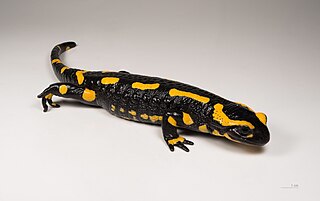
The fire salamander is a common species of salamander found in Europe.

The alpine salamander is a black salamander that can be found in the French Alps, and through the mountainous range in Europe. It is a member of the genus Salamandra. Their species name, atra, may be derived from the Latin ater, meaning dull black. The salamanders' coloration has evolved over time, as some species are completely monochrome black and others have yellow spotting and marks. Their life expectancy is at least 10 years. There are four subspecies of the alpine salamander, with varied distribution and physical coloration. Unlike other salamanders, whose larvae are developed in water, the alpine salamander and its subspecies are a fully terrestrial species in life and gestation. They give birth to live young.

The Caucasian agama is a species of agamid lizard found in the Caucasus, E/S Georgia, Armenia, Azerbaijan, Turkmenistan, Tajikistan, Dagestan (Russia), E Turkey, Iraq, N Iran, Afghanistan, NW Pakistan, and parts of Kashmir.
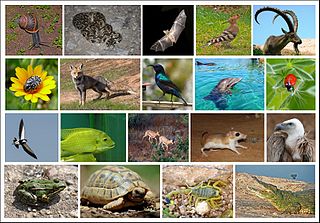
The wildlife of Israel includes the flora and fauna of Israel, which is extremely diverse due to the country's location between the temperate and the tropical zones, bordering the Mediterranean Sea in the west and the desert in the east. Species such as the Syrian brown bear and the Arabian ostrich have become extinct in Israel because of their loss of habitat. As of May 2007, 190 nature reserves have been established in Israel.

Onychodactylus fischeri is a lungless salamander found in Northeast Asia. It ranges through northeastern China, the Russian Far East, and the Korean Peninsula, but is only sporadically distributed within this range. Within South Korea, it is found chiefly in the high mountain valleys of Gangwon province, including the Gwangdeoksan and Daeseongsan regions. The adults feed on spiders, grubs, and insects. Common names include Fischer's clawed salamander and long-tailed clawed salamander.
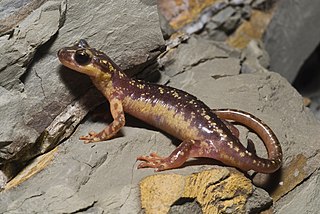
Lyciasalamandra is a genus of salamanders in the family Salamandridae. They are native to southwestern coast of Turkey and nearby Aegean Islands (Greece). As of early 2018, all species in the genus are threatened. The common name Lycian salamanders has been coined for them.
Lyciasalamandra flavimembris, the Marmaris Lycian salamander or Marmaris salamander, is a species of salamander in the family Salamandridae. It is endemic to Turkey and is found along the southwestern Anatolian coast between Marmaris and Ula. It was first described as subspecies of Mertensiella luschani, now Lyciasalamandra luschani.
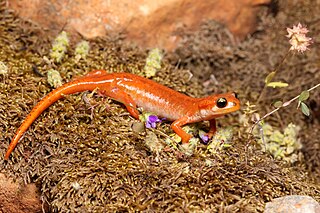
Luschan's salamander or Lycian salamander is a species of salamander in the family Salamandridae. It is found in the southwestern Anatolia in Turkey and adjacent Greece, in the island of Kastellorizo and its satellites.
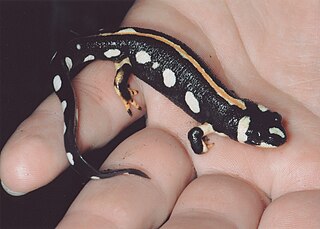
Neurergus is a genus of salamanders, more specifically newts, in the family Salamandridae. They are found in the Middle East, and are kept and bred in captivity for their bright colors. In nature, they inhabit streams and small rivers, and the surrounding forests or shrublands. All of the Neurergus are considered threatened species, primarily due to destruction of habitat and overcollection for the pet trade.
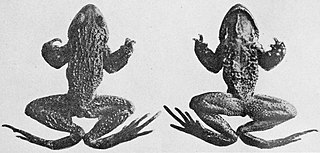
The Caucasian parsley frog is a species of frog in the family Pelodytidae. It is found in Azerbaijan, Georgia, Russia, Turkey, and possibly Armenia. Its natural habitats are temperate forests, temperate shrubland, rivers, intermittent rivers, freshwater marshes, intermittent freshwater marshes, and freshwater springs. It is threatened by habitat loss.

Ommatotriton ophryticus, the northern banded newt, is a species of newt in the family Salamandridae. It is found in northeastern Turkey and western Caucasus in Georgia, Armenia, and southern Russia.

Batrachochytrium salamandrivorans (Bsal) is a pathogenic chytrid fungus that infects amphibian species. Although salamanders and newts seem to be the most susceptible, some anuran species are also affected. Bsal has emerged recently and poses a major threat to species in Europe and North America.

Salamandra atra aurorae is a subspecies of the alpine salamander Salamandra atra found in south-eastern Italian Prealps. It is often called the golden alpine salamander.

Borjomi Strict Nature Reserve is a protected area in Borjomi Municipality, Samtskhe-Javakheti region of Georgia.

Darevskia portschinskii is a species of lizard in the family Lacertidae. The species is endemic to the South Caucasus region of Eurasia. There are two recognized subspecies.

The Caucasian smooth newt or Caucasian newt is a newt species found in the Caucasus region, from the Don river mouth in Russia to Georgia, and potentially Armenia, Azerbaijan and extreme northeastern Turkey. It occurs from sea level to 2,500 m (8,200 ft) elevation.

















